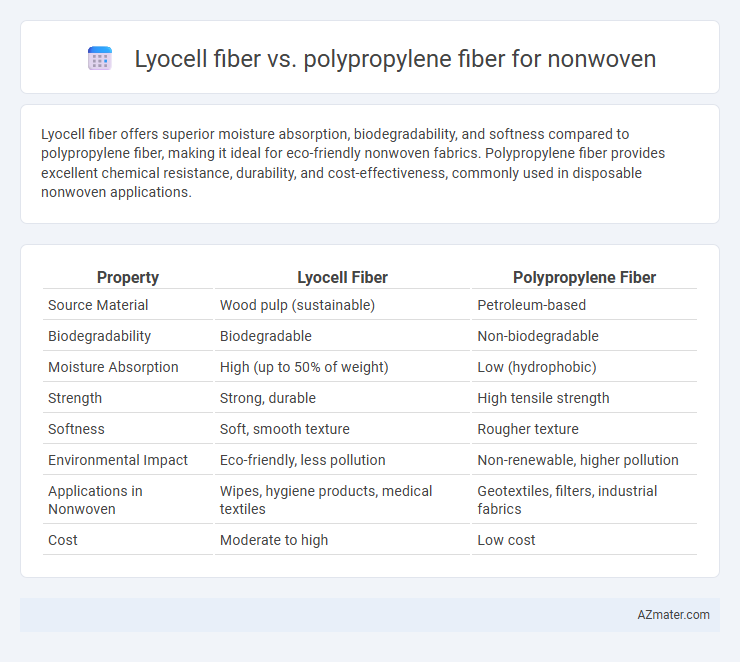Lyocell fiber offers superior moisture absorption, biodegradability, and softness compared to polypropylene fiber, making it ideal for eco-friendly nonwoven fabrics. Polypropylene fiber provides excellent chemical resistance, durability, and cost-effectiveness, commonly used in disposable nonwoven applications.
Table of Comparison
| Property | Lyocell Fiber | Polypropylene Fiber |
|---|---|---|
| Source Material | Wood pulp (sustainable) | Petroleum-based |
| Biodegradability | Biodegradable | Non-biodegradable |
| Moisture Absorption | High (up to 50% of weight) | Low (hydrophobic) |
| Strength | Strong, durable | High tensile strength |
| Softness | Soft, smooth texture | Rougher texture |
| Environmental Impact | Eco-friendly, less pollution | Non-renewable, higher pollution |
| Applications in Nonwoven | Wipes, hygiene products, medical textiles | Geotextiles, filters, industrial fabrics |
| Cost | Moderate to high | Low cost |
Introduction to Lyocell and Polypropylene Fibers
Lyocell fiber, derived from sustainably sourced wood pulp, is a biodegradable and highly absorbent material widely used in nonwoven fabrics for hygiene and filtration products. Polypropylene fiber is a synthetic, hydrophobic polymer known for its durability, chemical resistance, and low cost, making it a popular choice in nonwoven applications such as medical disposables and geotextiles. The key differences between lyocell and polypropylene fibers include biodegradability, moisture management, and environmental impact, influencing their selection based on product requirements.
Manufacturing Processes of Lyocell vs Polypropylene
Lyocell fiber is produced through a closed-loop process using dissolving wood pulp and N-Methylmorpholine N-oxide (NMMO) as a solvent, promoting environmental sustainability by recycling solvents and minimizing waste. Polypropylene fiber manufacturing involves melt spinning, where polypropylene pellets are melted and extruded through spinnerets to form filaments, offering high production speed and cost efficiency. The Lyocell process emphasizes eco-friendliness and fiber purity, while Polypropylene benefits from simpler, faster manufacturing suitable for mass production in nonwoven applications.
Fiber Structure and Morphology Comparison
Lyocell fiber exhibits a smooth, cylindrical structure with a highly uniform morphology that enhances fiber-to-fiber bonding and liquid absorbency in nonwoven applications. Polypropylene fiber features a rougher, irregular surface with a hollow cross-section, contributing to increased loft and bulk but lower absorbency compared to Lyocell. The compact, fibrillated structure of Lyocell enables superior mechanical strength and softness, whereas the hydrophobic nature and morphological openness of polypropylene fibers promote durability and moisture resistance.
Environmental Impact and Sustainability
Lyocell fiber, derived from sustainably managed eucalyptus wood pulp through a closed-loop solvent spinning process, offers superior biodegradability and minimal environmental footprint compared to polypropylene fiber, which is petroleum-based and non-biodegradable. Polypropylene's resistance to natural degradation contributes to persistent plastic pollution and challenges in waste management, whereas Lyocell supports circular economy principles through compostability and reduced reliance on fossil fuels. The renewable sourcing and lower emissions associated with Lyocell production make it a more sustainable choice for nonwoven applications seeking to minimize ecological impact.
Mechanical Properties and Performance
Lyocell fiber exhibits superior mechanical properties in nonwoven applications, offering high tensile strength, excellent elongation, and enhanced durability compared to polypropylene fiber. Its natural cellulose-based composition provides better moisture absorption and breathability, resulting in improved performance under stress and repeated use. In contrast, polypropylene fiber, though cost-effective and hydrophobic, tends to have lower mechanical resilience and less flexibility, limiting its applicability in high-performance nonwoven textiles.
Absorbency and Moisture Management
Lyocell fiber demonstrates superior absorbency in nonwoven applications due to its cellulose-based structure, enabling it to retain moisture up to 50% of its weight without feeling damp. Polypropylene fiber, being hydrophobic, exhibits low absorbency, making it ideal for moisture barrier layers but less effective for moisture management. Nonwovens combining Lyocell enhance comfort by efficiently wicking and distributing moisture, while polypropylene provides durability and resistance to liquid penetration.
Applications in Nonwoven Industries
Lyocell fiber offers superior moisture management, biodegradability, and softness, making it ideal for hygiene products, medical dressings, and wipes in nonwoven industries. Polypropylene fiber provides excellent chemical resistance, durability, and cost-effectiveness, widely used in geotextiles, filtration materials, and industrial wipes. Selection depends on application-specific needs such as environmental impact, strength, and fluid absorption.
Cost Analysis and Market Availability
Lyocell fiber generally incurs higher production costs due to its eco-friendly manufacturing process involving solvent spinning from wood pulp, resulting in premium pricing compared to polypropylene fiber, which is synthetically derived from petroleum and benefits from large-scale, cost-efficient production. Market availability favors polypropylene fiber, widely used in nonwoven applications such as hygiene products, medical fabrics, and filtration due to its abundant supply, low cost, and versatile properties; conversely, Lyocell's market presence is growing in specialized nonwovens targeting sustainability-conscious consumers but remains limited by higher prices and lower production volumes. Cost analysis reveals polypropylene as the economical choice for mass-market nonwovens, while Lyocell fiber commands a niche, high-value segment prioritizing biodegradability and skin-friendliness.
Biodegradability and End-of-Life Considerations
Lyocell fiber offers superior biodegradability compared to polypropylene fiber, as it is derived from natural cellulose and decomposes more readily in composting environments. Polypropylene fiber, a synthetic polymer, resists microbial degradation and typically persists in landfills for centuries. End-of-life management favors Lyocell nonwoven products due to their compatibility with industrial composting and reduced environmental impact, whereas polypropylene nonwovens often require energy-intensive recycling processes or result in long-term waste accumulation.
Future Prospects and Innovations in Nonwoven Fibers
Lyocell fiber, derived from sustainable wood pulp, exhibits superior biodegradability and moisture management, making it a promising material for eco-friendly nonwoven applications. Polypropylene fiber, known for its cost-effectiveness and excellent chemical resistance, remains dominant but faces increasing scrutiny over environmental impact. Innovations in lyocell-based nonwovens focus on enhancing mechanical strength and blending with biodegradable polymers, while advancements in polypropylene fibers aim to improve recyclability and reduce carbon footprint through bio-based feedstocks.

Infographic: Lyocell fiber vs Polypropylene fiber for Nonwoven
 azmater.com
azmater.com